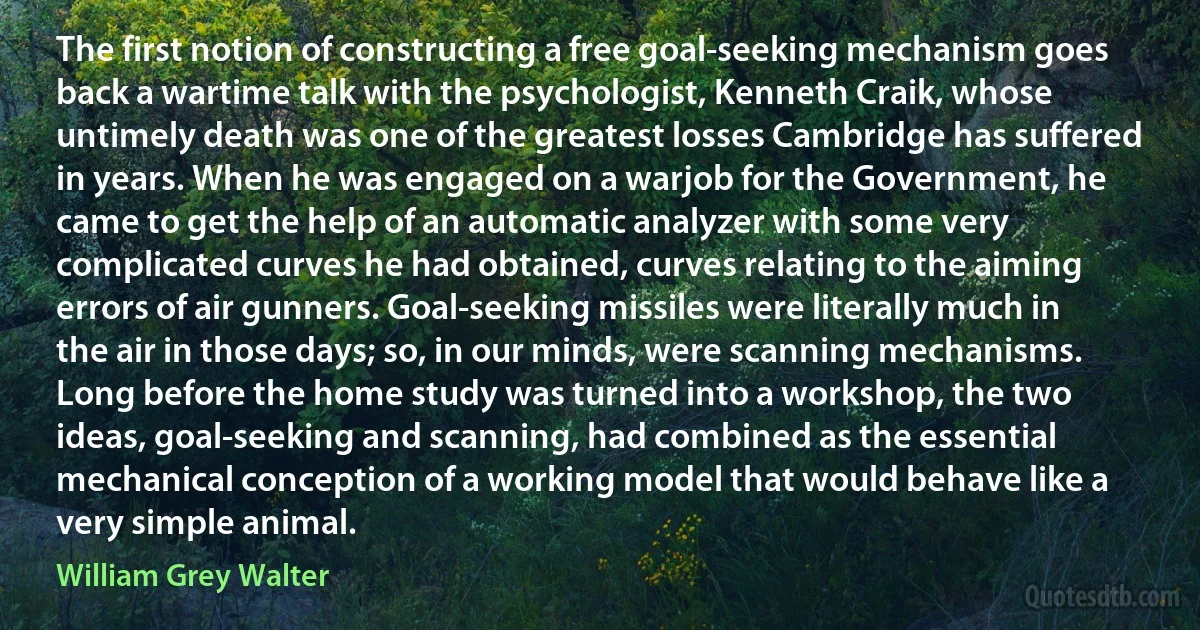
The first notion of constructing a free goal-seeking mechanism goes back a wartime talk with the psychologist, Kenneth Craik, whose untimely death was one of the greatest losses Cambridge has suffered in years. When he was engaged on a warjob for the Government, he came to get the help of an automatic analyzer with some very complicated curves he had obtained, curves relating to the aiming errors of air gunners. Goal-seeking missiles were literally much in the air in those days; so, in our minds, were scanning mechanisms. Long before the home study was turned into a workshop, the two ideas, goal-seeking and scanning, had combined as the essential mechanical conception of a working model that would behave like a very simple animal.
William Grey WalterRelated topics
air animal automatic came conception constructing death free government help home mechanism model psychologist relating scanning simple study talk working years days cambridgeRelated quotes
Right after the Flood, as all of the water went down, all of the decayed plant matter would have made the water very high in minerals and decayed plant and animal life would have been high in nutrients to make anything to grow. Food would have been readily available with all of the rotting carcasses of the vegetation and the animals. The coral could have grown much faster under these conditions, then it would have slowed down to its current rate. People who have studied coral reefs say that they could have been formed in four to five thousand years with no problem. If the earth is older than that, why aren't the the coral reefs much larger? Their rate of growth indicates a young age for the earth.

Kent Hovind
Mandela taught us the power of action, but he also taught us the power of ideas; the importance of reason and arguments; the need to study not only those who you agree with, but also those who you don't agree with. He understood that ideas cannot be contained by prison walls, or extinguished by a sniper's bullet. He turned his trial into an indictment of apartheid because of his eloquence and his passion, but also because of his training as an advocate. He used decades in prison to sharpen his arguments, but also to spread his thirst for knowledge to others in the movement. And he learned the language and the customs of his oppressor so that one day he might better convey to them how their own freedom depend upon his.

Barack Obama
You talk of Paine with more respect than he deserves: He is utterly incapable of comprehending his subject. He has not even a moderate portion of learning of any kind. He has learnd the instrumental part of literature, a style, and a method of disposing his ideas, without having ever made a previous preparation of Study or thinking-for the use of it. ... [Paine] possesses nothing more than what a man whose audacity makes him careless of logical consequences, and his total want of honour and morality makes indifferent as to political consequences, may very easily write. They indeed who seriously write upon a principle of levelling ought to be answerd by the Magistrate-and not by the Speculatist.

Edmund Burke
It rained. The procession of weary soldiers became a bedraggled train, despondent and muttering, marching with churning effort in a trough of liquid brown mud under a low, wretched sky. Yet the youth smiled, for he saw that the world was a world for him, though many discovered it to be made of oaths and walking sticks. He had rid himself of the red sickness of battle. The sultry nightmare was in the past. He had been an animal blistered and sweating in the heat and pain of war. He turned now with a lover's thirst to images of tranquil skies, fresh meadows, cool brooks - an existence of soft and eternal peace.
Over the river a golden ray of sun came through the hosts of leaden rain clouds.

Stephen Crane
No one mentioned Communism or the Hiss Case until we sat over our coffee in the living room. Mrs. Philip Jessup had just used her personal good offices to try to get me off TIME. Luce was baffled by the implacable clamor of the most enlightened people against me. "By any Marxian pattern of how classes behave," he said, "the upper class should be for you and the lower classes should be against you. But it is the upper class that is most violent against you. How do you explain that?" "You don't understand the class structure of American society," said Smetana, "or you would not ask such a question. In the United States, the working class are Democrats. The middle class are Republicans. The upper class are Communists."

Whittaker Chambers
